Ireland and the Spanish Armada 1588
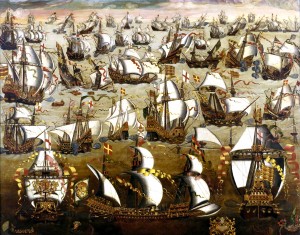
Ireland’s role in the inglorious end of Phillip of Spain’s attempt to invade England. By John Dorney
On September 16, 1588 seven Spanish ships appeared off Liscannor, sighted by Nicholas Cahane, an agent of Boetius Clancy, the High Sherriff of County Clare. They were the miserable remnants of a once mighty Spanish fleet.
They anchored off Kilrush, where the starving sailors attempted to trade with the locals for food and water. Six ships sailed away unscathed, but another, the Annunciada sank off Scattery Island, was set alight by crew and looted by locals. Two other ships were also lost: the San Estaban and San Marcos, with the loss of around 800 lives.
Crawling ashore, half drowned, malnourished and in no fit state to resist, the survivors, about 300 men, were massacred at Spanish Point by both Irish forces raised by the O’Briens and English soldiers led by the Sherriff, Boetius Clancy. [1]
Introduction-The Invincible Armada
The Spanish Armada, also known as the ‘Invincible Armada’ (La Armada Invencible), was an attempt by the Spanish King Phillip II at a seaborne invasion of the Kingdom of England. The Armada was the culmination of long running rivalry between England and Spain over strategic, trade and religious issues.
The Spanish Armada was the Spanish fleet charged with escorting the Spanish Army of Flanders to England’s shores.
The ‘Armada’ itself refers to the Spanish fleet assembled for the operation, which was intended to escort the Spanish Army of Flanders across the English channel, past the English fleet. Although Ireland had featured in previous drafts of Spanish invasion plans, it did not form a part of Spanish strategy in 1588.
Nevertheless, Ireland was, in the end, central to the defeat of the Armada. The Spanish fleet was blown north and west around the western Irish coast. As many as 27 ships and perhaps up to 9,000 Spanish soldiers and sailors lost their lives off the Atlantic coast of Ireland, either through drowning or were killed by English troops or Irish chieftains after they were washed ashore.
At the same time some Irish who were sympathetic to the Spaniards sheltered them and some kept them on as soldiers.
The European Context
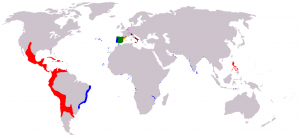
Spain was the leading power in Europe and arguably the world. Phillip II of the house of Habsburg inherited European possessions including not only the Spanish kingdoms of Castille and Aragon, but also the Kingdom of Naples in southern Italy, the Italian islands of Sardinia and Sicily, several principalities in northern Italy and what was then known as the Spanish Netherlands.
In 1580-81 when the King of Portugal died without an heir, Phillip managed to make himself head of that kingdom too, together with its Atlantic fleet and overseas possessions.
Spain was the superpower of 16th century Europe. England as yet was a bit player.
Additionally the Spanish crown controlled vast swathes of central and South America, including modern Mexico (‘New Spain’), and most of what is now Spanish-speaking South America (the Vice-Royalty of Peru). From there the Spaniards shipped back huge quantities of gold and other precious metals, which funded further conquests. Phillip’s empire also included the modern Philippines, and since the union with Portugal, the coast of modern Brazil and outposts in India and Africa as well.
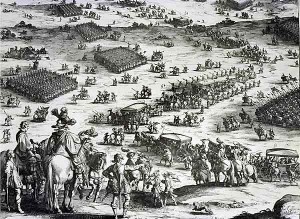
England by contrast, was not yet a major European power. It had no permanent standing army and though it controlled (as yet shakily) the Kingdom of Ireland, its foreign possessions paled in comparison with those of the Spanish monarchy – including only some outposts in north America and in modern Bangladesh.
The Anglo Spanish War broke out against the background of religious turmoil in Europe. The Protestant ‘Reformation’ aimed initially at Reforming the Catholic Church had by the late 16th century, hardened into a number of breakaway Christian faiths. At a time when the monarch was generally taken to be ‘God’s anointed’, where the subjects and the monarch differed over religion it almost inevitably led to civil war, as it did in France, the German states and, since the 1560s, between the Catholic Spanish rulers of the Netherlands (modern Netherlands and Belgium) and their predominantly Calvinist Dutch subjects.
Rivalry between Spain and England was part religious warfare and part strategic competition.
Between England and Spain and between their monarchs Phillip II and Elizabeth I there was personal religious animosity. Elizabeth’s father Henry VIII had broken with the papacy but his daughter Mary I, product of Henry’s marriage to a Spanish princess had reversed Henry’s policy and restored Catholicism as state religion. Mary married Phillip II of Spain who was thus (joint) King of England and Ireland with Mary between 1553 and Mary’s death, without children, in 1558.
When Elizabeth Tudor, who had been imprisoned under her sister Mary, took over as queen she reversed the counter-reformation and founded an enduring Protestant monarchy with a state Church of England.
This was a blow to Phillip’s pride, his religious scruples and represented a loss of a strategic ally, but was not enough in itself to spark war between England and Spain.
The Anglo Spanish War
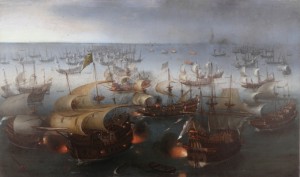
Starting in 1562, Elizabeth authorized English ‘privateers’ that is freelance naval captains, to raid Spanish shipping crossing the Atlantic. As so much of Spanish wealth depended on the importation of American gold this was a very serious potential risk to Spanish interests.
The stakes were further raised with the outbreak of rebellion against the Elizabethan English state in both northern England and southern Ireland (the First Desmond Rebellion, which last until 1573) in 1569. Both revolts had an aspect of Catholic crusade. The Pope Pius V formally excommunicated Elizabeth in 1570. This was a very serious matter as it meant that any Catholic monarch could legitimately overthrow her and that rebellions against her now had religious sanction.[2]
The Spanish decision to invade England and depose Elizabeth was taken after raids on Spanish shipping in the Atlantic and Carribean in 1586.
Both the Spaniards and the Papacy gave military aid to Irish Catholic Geraldine rebels 1579-80 in the Second Desmond rebellion and a 600 strong Papal force of both Italian and Spanish soldiers landed at Smerwick, in Kerry in 1580 to aid the uprising, only to be captured and massacred by English forces.[3]
Furthermore in 1584, Spain committed itself to fight the spread of Protestantism in France.
By way of reprisal, England began aid to aid Protestant Dutch rebels against Spain with troops and money 1585. So by the mid 1580s, England and Spain were locked in mutually antagonistic rivalry, both aiding what would now be called proxy forces in their respective domains.
However the final straw for Phillip II did not come until 1586, when English attacks on shipping off Galicia, the Canaries and the Caribbean caused significant losses in ships and cargo. Losses on this scale could not be allowed to continue and it was only now that Phillip II directed his ministers to prepare for an invasion of England to force a change of regime.[4]
The Irish Context
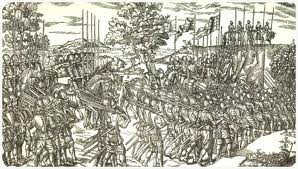
Where did Ireland fit in to this conflict?
Ireland prior to 1542 had been a ‘Lordship’ of the monarch of England. It was only in that year that that Henry VIII declared the Kingdom of Ireland and himself as King of Ireland. It was one thing however to proclaim himself thus and a very different thing to actually control the whole island.
At that date English Crown control extended no further than the Pale, a small fortified area based around Dublin on the east coast and a handful of coastal towns such as Waterford and Cork. Outside of that were dozens of what amounted to small kingdoms, some of which were controlled by lords of mixed Irish and English ancestry such as the Fitzgeralds of Kildare and Desmond and the Butlers of Ormonde and others by indigenous Gaelic Irish chieftains.
Henry’s plan was that Irish lords would ‘surrender’ their lands to him, be re-granted them under English law and become, over generations ‘civilised’ English aristocrats. They would abandon their private armies and also abandon Irish language and customs and also adopt the Protestant state religion. The English, throughout the century spoke of a religious and civil ‘reformation’ in Ireland.
Ireland was in middle of a process of violent absorption into the English monarchy – what the English described a ‘civil reformation’.
It would not be true to say that the Irish lords en masse rejected the advance of the English state in Ireland. Many did accommodate themselves to it and adopt English titles. But for a complex mixture of reasons, some because they did not want any intrusion into their territory by anyone, some because succession disputes or rivalry between Irish lordships dragged in English forces and also by resistance to the imposition of an alien culture and religion, the English ‘civilizing mission’ in Ireland was marked by bouts of ferocious military conquest.
The Desmond Rebellions, in 1569-73 and 1579-83, were a combination of all of these factors and ended in the destruction of the Fitzgerald Earldom of Desmond and the Plantation of Munster with English settlers in the 1580s. Historians disagree over the level of Catholic Counter Reformation penetration of Ireland in this period but it is undeniable that the rebels declared themselves to be fighting for the One True Faith against ‘heresy’ and actively sought military aid from Catholic Europe. Refugees from the Desmond wars ended up in Spain and to a lesser extent France.
The first Irish regiment in Spanish service was born in 1587 when an Irish unit raised under an English Catholic, William Stanley and sent to the Netherlands, defected to the Spanish side. [5]
As a result Ireland appeared to the Spanish to be an obvious weak point for England, with a restive Catholic population that could be mobilized in their favour.
As the reception of the Armada off Ireland’s west coast in 1588 would show, however, the reality of Irish politics was far more complex and fragmented.
The Composition of Connacht
Nowhere was this more apparent than in the western province of Connacht, where much of the Spanish fleet would end up in September 1588.
In an effort to establish military control over the province, the English created the ‘Presidency of Connacht’ in 1569. The President was an English Military Governor, based in Athlone, whose job it was to enforce English authority, taxes and culture in return for recognising the English titles of designated Irish lords. In return, the local chieftains were supposed to give up their private armed forces, except for a small band of personal retainers. This was known as the ‘Composition of Connacht’. In 1588 the Lord President was Richard Bingham. [6]
The ‘Presidency’ was often brutal and generally unpopular, but was not universally resisted.
The composition of Connacht was the imposition of English style land-holding on the province overseen by a military governor.
The Presidency worked to the advantage of the two biggest Lords in Connacht – O’Brien of Thomond (in modern Clare, then considered part of Connacht) and Burke of Clanricard (in modern south and east Galway), whose leading families kept a firm grip on succession and who consolidated their power over their dependent clans with English backing.
Elsewhere though, the English presence provoked serious violence. The MacWilliam Burkes of north Mayo, for instance revolted after the English attempted to back an unpopular candidate for chieftain in 1585. In the same year, in a scheme known as the Composition of Connacht, Irish titles were abolished and English settlers were introduced into the province, mainly on confiscated monastic land.
The MacWilliams, joined by other discontented chieftains such as Brian O’Rourke in Leitrim, fought English forces led by President Richard Bingham throughout 1586. Only after the slaughter of 800 Scottish gallowglass soldiers they had brought in did they, for the time being, submit. [7]
So in 1588, when the Spaniards ended up off the coast of Ireland, they may have expected to find a sympathetic Catholic population ready to help them. What actually existed however was a highly fragmented political scene, in which the loyalties of individual lords depended not so much on ideology as on their immediate relationship to English power.
Spanish Plans
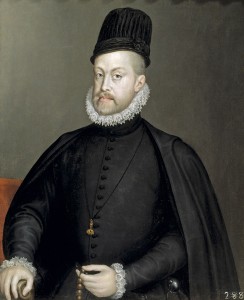
But the Spaniards, of course, never expected to arrive on Ireland’s west coast in 1588.
Spain was no stranger to naval warfare or to seaborne invasions. Sixteen years before the attack on England, at the battle of Lepanto 1571, a Spanish-led Catholic fleet –the ‘Holy League’ – had crushed the fleet of the Ottoman Turks, hitherto the dominant naval power in the eastern Mediterranean. And just six years previously in 1582, Phillip’s forces had successfully mounted an amphibious invasion of the Azores islands, the only Portuguese possession to resist the ‘Union of Crowns’ with Spain by force. [8]
While the invasion of England – an Atlantic power with formidable maritime expertise – was a challenge of a different order, it was clear that the Spanish threat to England was real.
Initial Spanish plans included a diversionary landing in Waterford but this was later dropped
Initially, Spanish strategists came up with a plan for a three pronged attack on England in 1586-87. Interestingly, this included a landing at Waterford, in south eastern Ireland in order to draw off English resources from the main assault over the English Channel. The Spanish fleet was to draw off its English counterpart as it went to deal with the Irish landing, and meanwhile the Spanish Army of Flanders was to cross the English Chanel unopposed.[9]
All had to be postponed however after the English naval commander Francis Drake launched a devastating attack on the Spanish port of Cadiz in 1587, destroying many ships and much of their stores.
The following year the Spaniards came up with a simpler plan. The ‘Invincible Armada’ – a fleet of 130 warships and supply ships, led by Duke Medina Sidonia – was to sail from Lisbon via Corunna, link up with the Army of Flanders, led by Allessando Farnese, the Duke of Parma. This force, 37,000 soldiers strong, was waiting at Calais to be escorted in a further 260 transport barges across the Channel onto the English coast. [10]
Had the Army of Flanders made it across the English channel there is little doubt there would have been ‘regime change’ in Protestant England.
There is little doubt that, had the Army of Flanders crossed into England, the veteran Spanish troops would have swept aside the raw English militias that Elizabeth could put into the field. In that event, Elizabeth was to be deposed and Parma was to act as interim military ruler until the Pope and Phillip II named a new, Catholic monarch. [11]
Elizabeth herself created a legend by addressing her troops at Tilbury in Essex, assembled (incidentally nowhere near the where the Spaniards intended to land) with the immortal words,
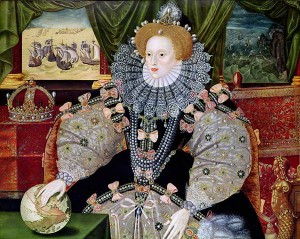
I know I have the body of a weak, feeble woman; but I have the heart and stomach of a king, and of a king of England too, and think foul scorn that Parma[12] or Spain[13], or any prince of Europe, should dare to invade the borders of my realm; to which rather than any dishonour shall grow by me, I myself will take up arms, I myself will be your general, judge, and rewarder of every one of your virtues in the field.[14]
Stirring words no doubt, but in reality everything, for the English depended on stopping the Spaniards from crossing the channel.
In this they had some advantages. Their fleet may have been smaller than the Armada, but in terms of well armed warships, suitable for northern seas the English may even have had the edge. The operation was at the very limits of what the Spanish Empire was able to accomplish. Some ships had had to be hijacked in Spanish ports and pressed into service for the invasion. Many others were Mediterranean vessels, unsuited for the wild seas of the Atlantic. Some cannon had been hurriedly cast and burst when fired.
Most importantly of all, Spanish logistics were insufficient. Not enough food or water was supplied and some of it was begin to spoil by the time the great Armada set sail from Corunna. Many sailors got sick and supplies were perilously low by the time they reached English waters. [15]
Sea Battle
Sea battle was joined from July to late August 1588 as the Armada fought its way towards the coast of Flanders. It culminated in fierce encounter off the Gravellines, or the coast of the Spanish Netherlands (modern Belgium), with the English attempting desperately to break up the Armada and to prevent it from reaching its rendezvous with the Army of Flanders.
The English under Admiral Howard succeeded in breaking up the Spanish formation by use of ‘fire-ships’, vessels set alight with pitch and tar and sent towards the Spanish fleet. In the fighting that followed, superior English gunnery managed to bloody the Spaniards somewhat and to keep them away from the Duke of Parma’s army at the disembarkation point at Calais.
Superior English gunnery prevented the Armada from linking up with its land forces but it was the weather and lack of supplies that defeated it.
However, this was a tactical defeat for the Armada, not a catastrophe – only 5 ships were lost, though many others were damaged. Medina Sidonia, in command of the Armada had other problems however. Logistics had always been insufficient and now food and water supplies were beginning to run out altogether. Moreover, a ‘Protestant Wind (southerly and westerly), in early September forced the Spanish to head for home, north around the coast of Scotland and Ireland back to Corunna.
This turned out to be a far more costly enterprise than the battle itself.
The Armada in Ireland
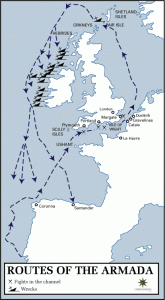
As the Armada rounded the northern Irish coast, it was in dire need of re-provision of both food and water. For this reason the fleet had to approach the unfamiliar coast of Ireland. There it was hit by westerly gales and crashed into the rocky Atlantic coast. In all 24 ships and c.5-7000 men lost off Ireland, mostly by drowning. All sailing ships were, to a degree, at the mercy of the weather, the Armada, many of whose vessels were built for the much calmer Mediterranean, was more vulnerable than most.
The Annals of the Four Masters recorded;
Great numbers of the Spaniards were drowned, and their ships were totally wrecked in those places. The smaller part of them returned to Spain; and some say that nine thousand of them were lost on this occasion. [16]
Those who made it ashore generally fared little better than those lost at sea.
The Armada lost far more ships and men wrecked off Ireland than it battle with the English fleet.
The English Lord Deputy of Ireland, Fitzwilliam, issued a proclamation whereby ‘Harbouring Castaways’ was punishable by death. To his own officers he wrote;
‘Whereas the distressed fleet of the Spaniards by tempest and contrary winds, though the providence of God have been driven on the coast… where it is thought, great treasure and also ordinance, munitions [and] armour hath been cast. We authorize you to… to haul all hulls and to apprehend and execute all Spaniards found there of any quality soever. Torture May be used in prosecuting this inquiry.’[17]
This chilling order, not to spare prisoners ‘of any quality [i.e. rank or social status] whatsoever’ was startlingly ruthless. Accordingly Richard Bingham, the President of Connacht, and his brother George Bingham, executed up to 1,100 Spanish survivors of the wrecks who made it ashore in the western province. For instance, at Galway city, 300 Spanish prisoners including 40 aristocrats were beheaded on Fitzwilliam’s orders – though Bingham apparently regretted the loss of ransom money. Only a handful such as Don Luis de Cordoba, managed to secretly buy their way to safety.[18]
English treatment of Spanish prisoners in Ireland was ruthless, almost all were killed.
Native Irish treatment of the Spanish survivors was extremely varied.
In Connacht, most Irish lords cooperated with Bingham, particularly the largest lords O’Brien, Earl of Thomond, and Burke, Earl of Clanricarde. Other clans such as the O’Flahertys also handed over Spanish prisoners. Others, seem simply to have seen the Armada as an opportunity for personal gain. Dubhdarach O’Malley Roe, on Clare Island, for instance killed the Spanish survivors and kept their gold for himself.
Elsewhere, at Streedagh in modern County Sligo for instance, where four ships were lost, the locals robbed the Spaniards of any valuables they could find, but did not kill them.
However, in modern north Mayo, Sligo and Leitrim, areas which had very recently been in armed revolt against the English Crown – chieftains such as MacWilliam Burke, and Brian O’Rourke harboured Spaniards. [19]
Though some Irish lords sheltered the Spaniards, it seems the majority either looted them or handed them over to the English.
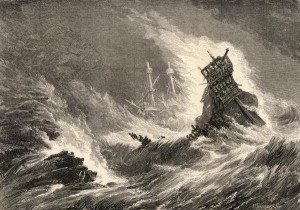
A rather ungrateful captain, Francisco de Cuellar, who was taken in by O’Rourke, wrote of ‘passing seven months among mountains and woods with savages’. Cuellar was shipwrecked on Streedagh beach, Sligo, spoke first of the ‘savages’ stripping and looting his ship, and the ‘English Lutherans’ hanging or cutting off the heads of his comrades wherever they captured them.
O’Rourke, whom he described as ‘a savage but a very good Christian and an enemy of the heretics, always carrying on war with them’, sent him through the territory of several other friendly clans including the McClancys and the O’Cahans to Derry, from where he secretly took ship back to the Spanish Netherlands. [20]
Although Cuellar reported that the Catholic Irish, with whom he conversed in Latin, repeatedly asked for a Spanish invasion, the Irish Annals were clear that, apart from O’Rourke and his allies, most of the Irish had sided with the Crown;
A great army was mustered by the Lord Justice of Ireland, Sir William Fitzwilliam; Sir Richard Bingham, Governor of the province of Connaught; and Sir Thomas Norris, Governor of the two provinces of Munster; together with the most of the men of Ireland… except the people of Ulster, the O’Rourke and Mac Sweeny-na-dTuath, who had formed friendship and alliance with some of the Spanish fleet which we have before mentioned. These forces spoiled every thing to which they came in their course, not belonging to the Queen’s people, from the Suck to the Drowes, and from the Drowes to the Finn. [21]
In Ulster, which was still largely outside of English control, the Spaniards seem to have fared somewhat better, at least if they survived shipwreck. In Antrim the Scottish/Irish MacDonnell clan led by Sorley Boy (Somhairle Buidh) helped up to 500 Spaniards escape to Scotland. [22].
The position of Hugh O’Neill, Earl of Tyrone, the most powerful northern leader, at this point still proclaiming himself a loyal subject to Elizabeth I, was hard to pin down. He sheltered and kept on a number of Spanish commanders to train his own forces, whom he was soon to lead in a war against the Elizabethan state. [23] Nevertheless, he also reported to Fitzwilliam the Lord Deputy that he had ‘put a large number of Spaniards to the sword’ in Inishowen (modern Donegal).[24]
Ironically enough, those Spaniards lucky enough to be shipwrecked in England itself were generally treated much more leniently. Most were taken prisoner and eventually repatriated.
Ireland, where English authority was tenuous enough for them feel that extreme ruthlessness was a necessity, was the real grave of the ‘Invincible Armada’.
Aftermath
The defeat of the Armada, as much by bad weather, poor planning and bad luck as by battle, seemed a providential escape to English Protestants – literally gift sent by God. Nevertheless, war between England and Spain continued indecisively until 1604 – an ‘English Armada’, sent to destroy the port at Corruna 1589 was itself defeated with 40 ships sunk and 10,000 men lost.
In Ireland itself the immediate effects of the Armada are hard to gauge. The frantic military activity all over the west destabilized the always fragile political situation there. North Connacht rose in rebellion again in 1589, though again, mainly over local grievances. Brian O’Rourke who had harboured many Spaniards fled to Scotland but was handed over to the English and hanged.
Certainly however, those areas, principally in the north, who had helped the wrecked Spaniards in 1588, helped to forge an enduring connection between Catholic Ireland and Catholic Spain.
During Hugh O’Neill and Hugh O’Donnell’s Nine Years War (1595-1603) against the English Crown, both lords were in constant communication with Phillip II, who aided them with weapons, money and finally a landing of Spanish troops at Kinsale in 1601-2.
Despite the fate of the Armada in Ireland, the late 16th century saw a strong bond created between Irish Catholics and the Spanish monarchy, through mutual hostility to Protestant England.
None of this should obscure the reality however that in the year of the Armada, the Irish weather and probably the majority of the Irish concerned helped to seal the fate of Spanish Armada.
This article is a version of a talk given at Kilrush, County Clare, on August 14, 2015 for the Office of Public Works (OPW). By My thanks to Padraig Og O Ruairc for inviting me.
References
[1] John O’Brien, The Other Clare, Vol 3, 1979, http://www.clarelibrary.ie/eolas/coclare/history/spanish_armada.htm
[2] See the Bull here http://tudorhistory.org/primary/papalbull.html
[3] Colm Lennon, Sixteenth Century Ireland, The Incomplete Conquest, Gill & MacMillan, Dublin 1994, p226
[4] Geoffrey Parker ,Empire War and Faith in Early Modern Europe, p50
[5] William Marmion, Irish regiments in the Spanish Army of Flanders https://www.theirishstory.com/2015/07/28/irish-regiments-in-the-spanish-army-of-flanders/#.VdNqkbJVhHw
[6] Lennon, Sixteenth century Ireland, p240-248
[7] Lennon, p249-255, Gallowglass refers to Gall Oglaigh, ‘foreign warriors’ traditional Scottish Gaelic soldiers for hire.
[8] Parker, Empire War and Faith p23-24
[9] Parker, Empire, War and Faith, p50
[10] Ibid. p55-57
[11] Ibid, p55-56
[12] Alessando Farnese Duke of Parma, an Italian who commanded the Spanish Army
[13] King Phillip II of Spain
[14] Online here http://www.bl.uk/learning/timeline/item102878.html
[15] Geoffrey Parker, Colin Martin, The Spanish Aramda, (1999), p140
[16] Annals of the Four Masters 1588, parts 10
[17] Calendar of Carew Manuscripts 1575-1588, online here.
[18] Parker, Martin The Spanish Armada, p224, see also this blog article http://ronangearoid.blogspot.ie/2011/01/1588-dark-year-for-galway.html
[19] Lennon, Sixteenth Century Ireland p237
[20] Captain Cuellar’s letters are online here http://www.ucc.ie/celt/published/T108200.html
[21] Annals of the Four Masters 1588, part 14, online here http://www.ucc.ie/celt/online/T100005E/text009.html
[22] Parker, martin The Spanish Armada, p225
[23] Ibid. P228
[24] Hiram Morgan, Tyrone’s Rebellion p106